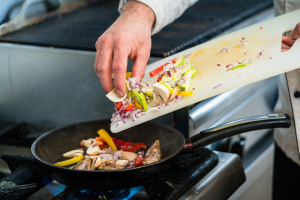 Although the produce section at the grocery store may look vast, it only represents a fraction of edible, nutritious, and tasty plant foods. It’s estimated there are more than 20,000 species of edible plants, and that we only eat about 20 to 50 of them. As a result, this may be playing a significant role in the rapidly declining health of westerners. Our gut bacteria, or gut microbiome, is a foundation to our health, and healthy gut bacteria depend on a diverse and ample array of vegetables.
Although the produce section at the grocery store may look vast, it only represents a fraction of edible, nutritious, and tasty plant foods. It’s estimated there are more than 20,000 species of edible plants, and that we only eat about 20 to 50 of them. As a result, this may be playing a significant role in the rapidly declining health of westerners. Our gut bacteria, or gut microbiome, is a foundation to our health, and healthy gut bacteria depend on a diverse and ample array of vegetables.
Ancient humans harvested wild fruits, nuts, and seeds that varied with the seasons. They also dug up underground roots and stems. Studies of the Hadza people, in Tanzania, one of the last remaining hunter-gatherer populations left on the planet, gives us additional insight into the human microbiome and health.
The Hadza have one of the most diverse gut microbiomes on the planet; Americans have the worst. The Hadza gut microbiome diversity is about 40 percent higher than that of the average person in the United States.
Americans consume an average of 15 grams of fiber a day, most of it coming from grains. The American Heart Association recommends eating 25 to 35 grams a day. Some microbiome authors suggest even higher amounts — at least 40 grams of fiber a day.
In contrast, the Hadza consume about 100 to 150 grams of fiber a day, with the average Hadza person eating almost 600 species of plants that vary with the seasons. They suffer almost none of the same diseases that have come to characterize the average American — obesity, diabetes, autoimmune diseases, and cancer.
Studies show fiber also lowers heart disease risk by binding with “bad” cholesterol to remove from your body. A high-fiber diet also lowers high blood pressure and thus the risk of stroke.
They type of fiber you eat matters too. What gut bacteria need for optimal function are “prebiotic” fibers mixed in with a diverse array of produce.
Prebiotic fibers best feed the healthy bacteria in our guts, thus improving overall health. Good sources of prebiotics include all vegetables but especially:
- Garlic
- Jerusalem artichokes
- Jicama
- Dandelion greens
- Onions
- Peas
- Broccoli
- Brussels sprouts
- Fruits
- Beans
Not only do prebiotic fibers help with bowel regularity, they also change the composition of the gut microbiome in a favorable direction. They help strengthen intestinal walls, improve absorption of important nutrients, produce hormones that control appetite, reduce anxiety, and help protect you against chronic disease.
If you’re not used to eating high amounts of plant foods loaded with fiber, don’t double or triple your intake overnight. Your gut may rebel with constipation, diarrhea, pain, bloating, and gas. It takes your digestive system and gut microbiome some time to adapt and be able to adequately digest large amounts of fiber. Gradually increase the amount of fiber you eat by 1 to 2 grams a day over several weeks to give your system time to adjust.
Also, you may have noticed legumes, or beans, are especially high in fiber. It’s tempting to make those a staple in your diet as a result, and if they don’t disturb your health then go for it. However, many people cannot tolerate the lectins in legumes — they trigger inflammation or autoimmune flare-ups. For people with SIBO, small intestinal bacterial overgrowth, they also cause intense digestive issues and inflammatory responses.
Also, some people need to avoid nightshade vegetables because they trigger inflammation, particularly in relation to arthritis. These include eggplant, potatoes (but not sweet potatoes or yams), peppers, tomatoes, tomatillos, hot pepper products (cayenne, Tabasco, etc.), and pepper-based spices. Simply removing nightshades from the diet has brought relief from joint pain for many, especially those with rheumatoid arthritis.
Lastly, some people have gut or immune disorders that make a high-fiber diet inappropriate until they resolve those. Ask me for more information if eating fiber makes you miserable.
What does a high fiber paleo diet look like?
Most people with chronic inflammatory and autoimmune disorders fare best on a paleo diet that eliminates grains and legumes. As grains and legumes are sources of high fiber, what does a high-fiber paleo diet look like?
The recommended produce consumption is seven to 10 servings a day. That may sound like a lot, but one serving is a half-cup of chopped produce, or a cup of leafy greens. Because sugary foods can be inflammatory, aim for veggies and fruits that are low in sugar and unlikely to destabilize your blood sugar.
Therefore, shoot for at least three to four servings of produce per meal – that’s 1.5 to 2 cups of chopped veggies or 3 cups of leafy greens. Or break that up into five meals if you eat more frequently to stabilize low blood sugar.
Ask my office for more ways to support your gut microbiome.






